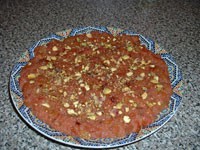For Arab Americans, It’s Not Thanksgiving Without Hashweh
BY: REEM KASSIS
The rice-based stuffing is often a centerpiece of celebrations in the Arab world, and on holiday tables in the United States.
Credit…Christopher Simpson for The New York Times. Food Stylist: Simon Andrews.
Rasha AlMahroos thinks of her Thanksgiving table and chuckles: A big turkey sits in the center, and right next to it, as if hiding under its wing, a very small chicken.
“My mother-in-law cannot get used to turkey, so she always stuffs a tiny chicken with hashweh,” said Ms. AlMahroos, a lawyer who was born in Bahrain and now lives in the Washington, D.C., area.
Rare is the Arab Thanksgiving table in America that does not include some version of hashweh, which means “stuffing” in Arabic.
In the Arab world, the rice-based dish is used to fill a whole lamb or chicken — meats that are often the centerpieces of celebratory meals. For more casual occasions, hashweh is also served on its own, generously topped with fried nuts. The fragrant rice, flavored with warm spices like cinnamon, nutmeg and allspice, combines with tender meat and crispy nuts for a dish of comforting contrasts.
Fadi Khayyat, a Palestinian American who immigrated to the United States from the city of Ramallah, in the West Bank, as an 8-year-old in 2003, remembers the first Thanksgiving his family celebrated. “My mom thought she could stuff turkey the way we do chicken,” said Mr. Khayyat, who lives in New York City. “Then she heard it’s not safe because of temperature issues, so now she just makes hashweh on the side.”
Over the years, Mr. Khayyat’s family has started to include more American dishes, but “hashweh is always the real star,” he said. Eating any large cut of meat without rice is baffling to him.
“The turkey always has to be next to hashweh topped with pine nuts and yogurt,” he said. “If anybody ends up with dry turkey, just serve it with hashweh and yogurt, then nobody will complain about it.”
In the same way, Ms. AlMahroos, 39, cannot fathom having an azoomah — a feast or gathering of people over food — without rice. Taking a cue from her native Bahrain, Ms. AlMahroos’s hashweh rice is flavored with cinnamon, cumin and turmeric, and has raisins alongside the nuts. “A large cut of meat has to come with rice to be presentable to guests,” she said.
Hospitality is the bedrock of Arab culture, most often manifested through food. Rice-based dishes happen to be the ones that extend the most to feed a large crowd, making them the perfect choice for an Arab Thanksgiving table. Just as Arabs blend these traditions with American ones, local and seasonal ingredients are also making their ways into classic Arab hashweh.
Omaya Atassi, 35, a Syrian American food writer and photographer in Dubai who grew up in the suburbs of Chicago, makes hashweh, or riz mtabal (spiced rice) as Syrians sometimes refer to it, year-round. For Thanksgiving, though, her hashweh gets a face lift: “We use chestnuts instead of the fried nuts because of the holiday season,” she said. “Their sweetness contrasts perfectly with hashweh’s warm spices.”
For Marguerite Lian-Hajjar, hashweh is a symbol of continuity and connection to the past. A third-generation descendant of Syrian and Lebanese immigrants, Ms. Lian-Hajjar, 60, still makes hashweh the way her “sitti,” or grandmother, did, out of her 2-by-4-foot kitchen in Brooklyn.
“Hashweh is a symbol of our mothers and their mothers before them,” she said. “There’s fewer and fewer ties to our past. Food is the strongest one that keeps us connected.”








